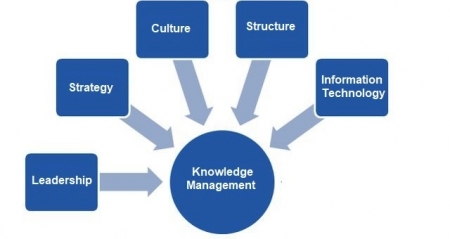Many of today’s executives agree with Doyle McCarthy, who sees society as a product of knowledge (1) with various forms of knowledge and symbols making up an organization’s culture. However, knowledge actually is a by-product of culture, and knowledge’s role in guiding and facilitating people’s actions is key to executive decision-making. Knowledge also creates values, thereby fulfilling the strategic functions of “producing and guiding social action, of integrating social organizations, of protecting the identity of individuals and groups, of legitimatizing both actions and authorities, and of serving as an ideology for individuals, groups, classes, and entire nations” (2).
In addition, Thomas Beckman explains that knowledge management is “the formalization of and access to experience, knowledge, and expertise that create new capabilities, enable superior performance, encourage innovation, and enhance customer value,” (3). Bernard Marr and his colleagues define knowledge management as a set of activities and processes aimed at creating value through generating and applying intellectual capital (4).
Moreover, knowledge management also has been regarded as a “conscious strategy of getting the right knowledge to the right people at the right time and helping people share and put information into action in ways that strive to improve organizational performance” (5). Executives direct practices that create value from intangible organizational resources. For executives, it is clear that the objective of managing knowledge is to add value to organizations. Executives need to consider the fact that a firm’s knowledge is positively associated with its outcomes. Executives can use the model proposed below to improve knowledge management performance in their companies.
Previous Academic Research
Executives who manage knowledge and use it as an important driving force for business success find their organization to be more competitive and on the cutting edge. However, knowledge management implementation in organizations is determined by a set of critical success factors, one of which is the strategic dimension of leadership. For now, executives can develop conducive organizational climates that foster collaboration and organizational learning in which knowledge, as a driver of improved performance, is shared and exploited. Academicians point out that that if leaders do not adequately support knowledge dissemination and creation through various mechanisms such as rewards or recognition for employees who create new ideas or share their knowledge with others, knowledge management cannot be successful.
Furthermore, it is safe to say that knowledge management effectiveness can be enhanced today with the use of information technology. Information technology can play a critical role in the success of knowledge management. For instance, scholar Kuan Yew Wong in Universiti Teknologi Malaysia (UTM) highlights the importance of information technology in facilitating knowledge flow and communication (6). Ying-Jung Yeh and his colleagues in the National Taiwan University of Science and Technology and National Chung Cheng University indicate that the effectiveness of knowledge management implementation is positively associated with using information technology and setting up useful software and systems to enhance strategic decision-making (7). Effective leaders, therefore, can develop information technology through employing IT professionals and allocating more budgetary resources to share and utilize knowledge within organizations.
Moreover, it is clear that executives around the globe realize they play a critical role to achieve the best climate for implementing knowledge management that creates learning and organizational growth. Engaging followers and getting them to participate in leadership activities is an important part of knowledge management practices. Scholars subsequently suggest that success also depends on how executives formulate their organization’s mission, vision, and strategy. The key is for executives to inculcate an effective strategy, culture, and structure so that information can be found and used instantaneously. The fact that executives steer the strategic direction of organizations is indicative of empowering people and making them more responsive to the constant changes in technology, economic fluctuations, and other pertinent and vital changes that occur on a day-to-day basis.
The Proposed Model
Figure 1 below is a model based on an integrated framework of the above ideas and scholarly research. This framework of the model highlights a relationship between five critical factors: knowledge management, leadership, strategy, culture, structure, and information technology. In the model, leadership has a positive impact on knowledge management, which leads to higher knowledge management performance. And finally, better strategy, better culture, better structure, and better information technology lead to better knowledge management performance.
Figure 1: The Proposed Framework

If organizational factors are not completely in favor of supporting knowledge management, companies cannot effectively implement knowledge management projects and may become obsolete, taken over, or acquired.
References
1. McCarthy, E.D. (1996). Knowledge as Culture: The New Sociology of Knowledge, New York: Routledge.
2. Strasser, H., & Kleiner, M. (1998). Knowledge as Culture: The New Sociology of Knowledge, European Sociological Review, 14(3), 315-318.
3. Beckman, T.J. (1999). The Current State of Knowledge Management. In J. Liebowitz, (Eds.), Knowledge Management Handbook, New York: CRC Press.
4. Marr, B., Gupta, O., Roos, G., & Pike, S. (2003). Intellectual Capital and Knowledge Management Effectiveness. Management Decision, 41(8), 771-781.
5. O’Dell C., & Grayson C.J. (1998). If only we knew what we know: identification and transfer of international best practices, New York: Free Press.
6. Wong, K.Y. (2005). Critical Success Factors for Implementing Knowledge Management in Small and Medium Enterprises. Industrial Management & Data Systems, 105(3), 261-279.
7. Yeh, Y.J., Lai, S.Q., & Ho, C.T. (2006). Knowledge management enabler: a case study. Industrial Management & Data Systems, 106(6), 793-810.
Mostafa Sayyadi, CAHRI, AFAIM, CPMgr, works with senior business leaders to effectively develop innovation in organizations, and helps companies—from start-ups to the Fortune 100—succeed by improving the effectiveness of their leaders. He is a business book author and long-time contributor to HR.com and Consulting Magazine.




